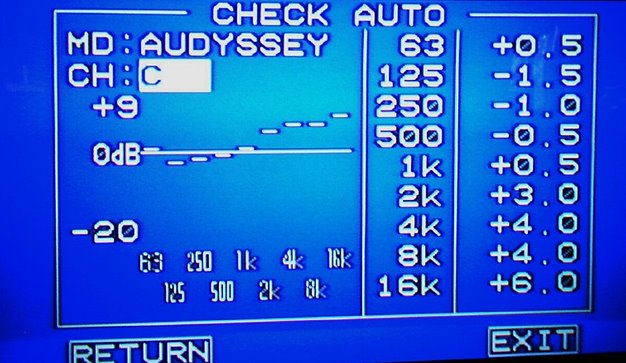Audyssey
The SR8001 uses the "Multi-EQ" iteration of Audyssey's room equalizer
software (the stand-alone version of Audyssey's system, called Audyssey
Sound Equalizer, is sold primarily to installers). There are
several different versions of the software licensed to A/V
manufacturers. In the "Multi-EQ" version found in the SR8001, you first
connect the supplied microphone (shown below), which is different than the
usual saucer-shaped calibration microphones found in most similarly equipped
receivers.

Once connected, the Audyssey sends a series of
test tones through every channel in the system (eight in my case, seven main
channels plus the subwoofer). The test tones sound like a Star Wars
blaster instead of the usual white noise tones found in other products.
The first set of tones confirm the speakers
that are connected in the system, and that they are wired in phase. Next,
you place the microphone in the prime listening location, then let the
Audyssey send another series of tones to each of the channels.
Unlike many other products, this iteration of
Audyssey allows you to select up to six different locations. In fact, the
manual recommends that you allow the software to run tones in six different
locations to maximize the utility of the software. Once completed, the
system does the number crunching. If you use all six microphone placements,
this processing can take up to ten minutes, but it's worth the wait.

Once finished, the OSD shows you the speaker
size, distance, crossover, and EQ, then asks you to store the results. Once
stored, the EQ function can be disabled with a single button push.
Alternatively, you can use other automatic modes such as "Front" (which
matches the characteristics of each speaker to the front speakers), or
"Flat" (which flattens the frequency response of all speakers regardless of
room acoustics, designed primarily for listening to multi-channel music such
as DD or DTS encoded DVDs). You can also choose to ignore the Audyssey's EQ
setting, and manually set each channel's EQ using the "Preset" function,
which allows the user to adjust nine bands of EQ for each of the seven main
channels.

Once Audyssey completed its mission, I
double-checked its findings ("Trust but verify" says the old Russian
proverb!) Audyssey's speaker distance (measurable in 0.1 feet increments)
and speaker volume settings (adjustable in 0.5 dB steps) were spot-on.
Viewing the EQ settings on the OSD (onscreen display), it appeared that
Audyssey, while making only minor adjustments in the sub-1 kHz spectra,
decided that my front channels needed a major boost in the upper
frequencies.
Judged solely on the OSD settings, one might
conclude that the MultEQ had added too much boost to the high frequencies.
However, looks can be deceiving. The Audyssey program involves sophisticated
time and frequency domain adjustments that donít translate well into the
simple, DOS-based graph shown on the OSD (rumor has it that Audyssey
discourages manufacturers from including the on-screen displays for just
that reason). In fact, a couple of two-channel white noise tests (our test
equipment only allows testing two channels at a time), confirmed that the
Audyssey's adjustments made only modest changes to the overall in-room
response, as shown below in the room response graph.

Of course, part of the beauty of the Audyssey
system is that you can use its settings as a starting point, then customize
them using the "Preset" manual EQ settings to tailor the adjustments to your
personal preferences. Once I accepted the Audyssey settings, the Marantz was
cleared for take-off.
The Sound
I couldn't resist the temptation to put on Who's Next (again) so I
could re-live my first Marantz experience, and it was just as good the third
time around. Because the SR8001 includes HDCD decoding (an increasingly rare
feature) it gave me an excuse to indulge a guilty pleasure, the B-52's
"Roam" from the Songs For A New Generation compilation CD. Despite
the overly compressed mix, Kate Pierson's distinctive voice, with a soft
Southern drawl that can change from a husky growl to a lilting falsetto in
mid-phrase, was a real treat. The Marantz brought Kate into my living room
like it was an intimate setting (I'd say more, but my wife might be reading
this).
Movies were just as satisfying an experience. Martin Scorsese's The
Departed, which won the director a belated Best Director Oscarģ,
has got a little bit of everything in its audio tracks: fast-moving dialogue
with thick Boston accents, unexpected jolts of intense violence, and the
Rolling Stones providing the atmospherics. The SR8001 had plenty of headroom
for the sudden bursts of gunfire, while anchoring the actors' voices across
the front of the soundstage.
Conclusions
It's impossible to attempt A/B testing with components that were in my rack
over a year apart, but general impressions remain. My (admittedly
subjective) take is that the SR8001 produces noticeably better quality sound
than its predecessor. Since the two Marantz receivers apparently share the
same DACs, the likely explanation is the lower noise floor and increased
headroom afforded by the toroidal transformer and higher powered amplifier.
The Marantz has it where it counts: the ability to reproduce accurate and
detailed sound. Combined with the flexibility to send HDMI signals from four
sources into two different displays, audio to three separate zones, and the
Audyssey calibration and EQ capabilities, the SR8001 will anchor many a
happy consumer's home theater.
- Ross Jones -